The simplest way to get there is from the top of the road that climbs up from the bay. Turning left at the signpost, you walk along a broad path. At one point it’s ankle-deep in mud, like most Gower footpaths in this damp and Covid-walker winter. Suddenly the path opens out into a field.
The obvious way forward is a path marked as the high-tide alternative Coast Path. It slopes downhill towards a metal gate at the south-east end of the field. But I never take this path. Instead, I keep to the old grassed-over cart track that climbs gently across the top of the field. Maybe this is the more ancient route: on leaving the field it turns into a steep path that leads down to the seventeenth century farm in the bottom of the cwm.
The field has been here since 1844 at least, because it’s marked as Homestead Cliff (field 891) on a tithe map of that date. Then it was owned by Thomas Iltid (Illtud?) and farmed as pasture by David Webborn. The Glamorganshire Ordnance Survey map of 1878 renumbers it as field 807 (the metalled road looks like it was not much more than a track at that time). But the field’s a lot older than 1844. Maybe it was first enclosed in the eighteenth century.
A third of the way along the cart track I usually stop, by a thick tangle of gorse and bramble. Few people notice it, but hidden inside this little spinney is a small wooden bench. Originally it might have been more visible, but the thorns have gradually overcome it. ‘Bench’ is a bit of an exaggeration. There’s just enough room for one person to squeeze past the gorse and sit down. The seat has just two thin, worn slats, held together by four round metal bolts. One of the seat’s legs has sunk over the years and the slats lean to the right, so it becomes slightly uncomfortable to stay there too long.
But this is where I sit and watch. Whoever set up the bench knew what they were doing. From here I can see most of the field. It’s a nondescript field, mostly grass but dotted with untidy thickets of gorse and the occasional holly, symbolised by little ‘hedgehog’ symbols on the 1878 map. Ancient hedges enclose it. It slopes quite steeply down in the direction of the sea. Beyond its southern edge, where the old map notes a lime kiln, I can see the sea – not the cove beach itself, but the triangular patch of water beyond it, and the sea cliffs that form a rough V-shape (the bare west hill is much steeper and higher than the wooded east one). On calm days paddle-boarders inch their way across the water and vanish out of sight to the west. On clear days I can see Exmoor in the distance.
This is a quiet place – it’s far enough away from the road for no traffic noise to reach it – but it’s not a secret, unvisited place. If I sit in my gorse-seat long enough I’m likely to see a few people walking along the field’s lower path, below me. They seldom look up or notice me. Today, unusually, I’m passed by someone I know, with her daughter. Otherwise, the place is mine. Unless there are noisy children down in the cove or the cwm, the only sounds around me are made by mammals. Most are birds – crows, gulls, magpies, blackbirds, robins and tits. In winter they tend to keep to the woodland in the cwm – by February they’ve recovered their singing voices – and today few of them share the field with me.
I sit on the bench in the weak sun. The field faces south, so it catches what light there is in winter, and it’s shielded from all but southerly winds.
I’ve known this field for years, but it’s only since the beginning of Covid that it’s begun to exert a strange influence on me. When I was young I used to wander for miles on my own outside our village – in a way that would attract accusations of parental neglect these days – and I always had a few ‘special’ places that I thought of as my own. One of them was the small field you came across suddenly at the end of the long wood at the back of our garden, just before the farm called Guyder Bottom. I would spend hours here, wrapped in my own world. Now, sixty years later and two hundred and fifty miles distant, I seem to have rediscovered the same curious habit, in this new field.
So I sit here, on the tiny, sloping bench surrounded by yellow gorse, and watch. I haven’t brought a mobile or a book. The world outside the field can’t break in. I sit and watch and wait. I wouldn’t claim that I enter any trance or altered state. The most I’d say that I reach the equivalent of what the old Epicureans used to call ‘ataraxia’ – a kind of calmness gained negatively, by shutting out thoughts that ‘perturb’ the mind. With the aid of the field I can evict, for a short time, fears about Covid, anger about politics, and anxieties about most other things. I can imagine that the bench and its spiny blanket lend me some sort of invisibility shield, a brief immunity from trouble.
After twenty minutes or so the sitting starts to become uncomfortable, and the dampness in the wooden slats has transferred itself to my trouser bottoms. Another Zoom call awaits. I ease my way gently past the thorns, and walk back down the old cart-track to the muddy path and the road home.








Leave a Reply